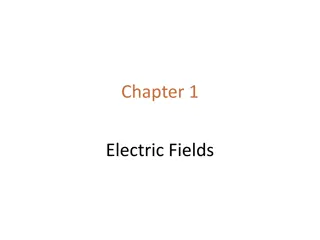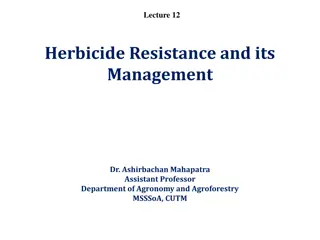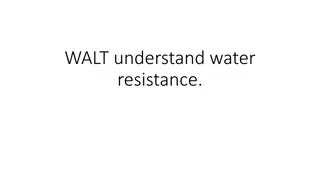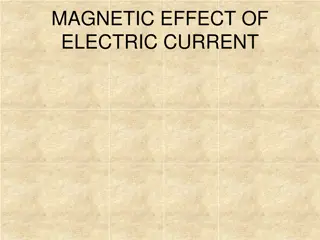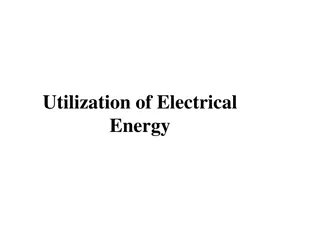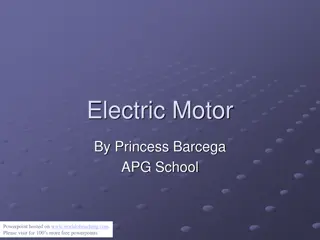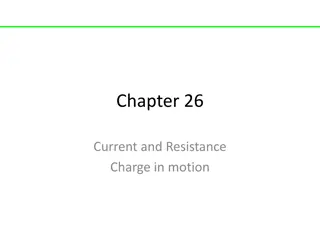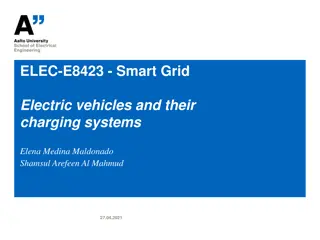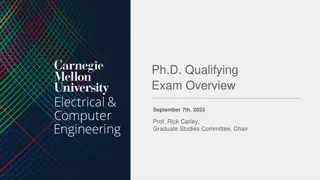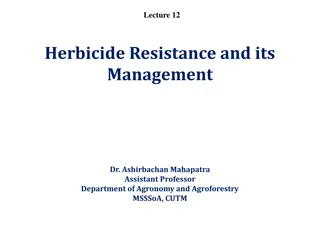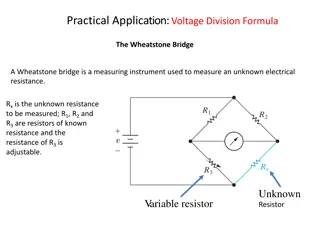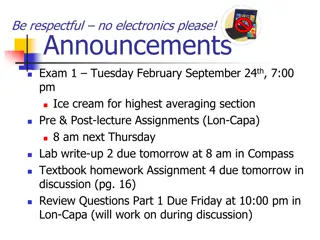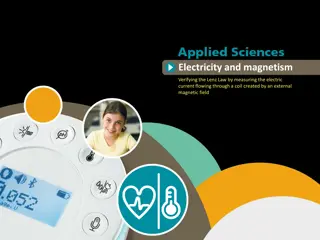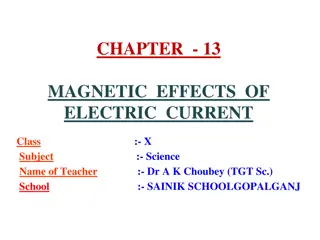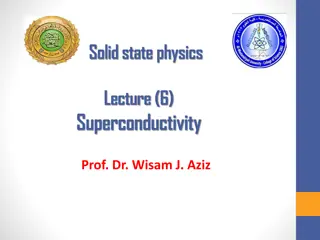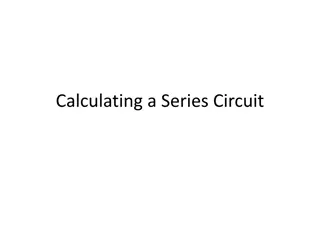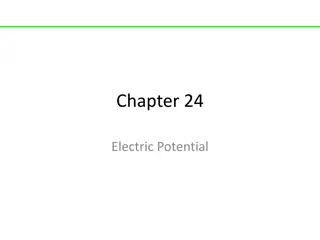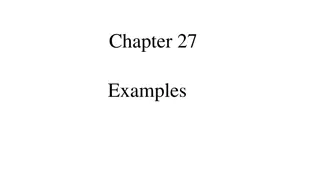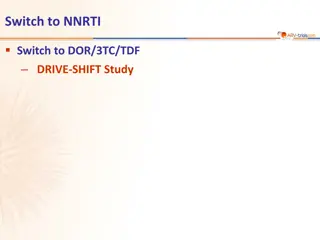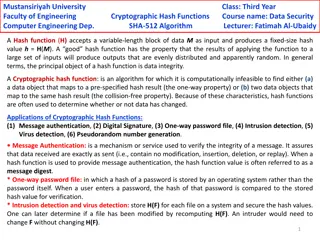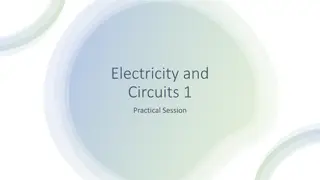Electric Current and Resistance: Lecture Highlights and Mid-term Exam Reminder
Today's lecture covers topics on electric current, resistance, Ohm's Law, resistors, resistivity, electric power, and microscopic views of current flow. Important announcements include reading assignments, mid-term exam details, online class rules, and exam guidelines. A refresher on electric current is also provided. Students are reminded to prepare for homework #8 due by Mar 30. Language: English
Download Presentation

Please find below an Image/Link to download the presentation.
The content on the website is provided AS IS for your information and personal use only. It may not be sold, licensed, or shared on other websites without obtaining consent from the author. Download presentation by click this link. If you encounter any issues during the download, it is possible that the publisher has removed the file from their server.
E N D
Presentation Transcript
PHYS 1444 Section 002 Lecture #13 Monday, Mar. 23, 2020 Dr. Jaehoon Yu CH25 Electric Current and Resistance Ohm s Law: Resisters, Resistivity Electric Power Alternating Current Microscopic View of Electric Current Ohm s Law in Microscopic View Today s homework is homework #8, due 11pm, Monday, Mar. 30!! Monday, Mar. 23, 2020 PHYS 1444-002, Spring 2020 Dr. Jaehoon Yu 1
Basic Rules of the Online Classes I will take attendance as if we are in the class room! Turn on your mic when joining the class but then mute once you have answered to the roll call! All mics must be muted unless you have a question I will unmute all of you when I ask you a question for interactivity! If you have a question, turn on your mic, pronounce your name and ask your question Use appropriate languages on mic and on chat! You can only chat with me You will be assigned into random breakout rooms for example problem solving. Please discuss amongst yourselves to take advantage of the session! No recording of the lecture is permitted! Monday, Mar. 23, 2020 PHYS 1444-002, Spring 2020 Dr. Jaehoon Yu 2
Announcements Reading Assignments: CH25.9 and 25.10 Mid-term Exam Wednesday, Mar. 25 via Quest No free tries! Once submitted, you cannot change the answer! So be very careful! First join in zoom class at 1pm and then move onto the exam on Quest at 1:05pm through 2:25pm Keep zoom on so that if you have any questions to me, type your questions in the chat window Covers CH21.1 through what we finish today, Monday, Mar. 23 (CH25.7?) + the math refresher You can use your calculator but DO NOT input formula into it! Cell phones or any types of computers cannot replace a calculator! Turn off your phones!! BYOF: You may prepare a one 8.5x11.5 sheet (front and back) of handwritten formulae and values of constants No derivations, word definitions or solutions of any problems! Let s be fair to other students and not cheat! There will not be any department colloquia this semester Monday, Mar. 23, 2020 PHYS 1444-002, Spring 2020 Dr. Jaehoon Yu 3
Refresher: Electric Current When a circuit is powered by a battery (or a source of emf) the charge can flow through the circuit. Electric Current: Any flow of charge Current can flow whenever there is a potential difference between the ends of a conductor (or when the two ends have opposite charges) The current can flow even through the empty space under certain conditions Electric current in a wire can be defined as the net amount of charge that passes through the wire s full cross section at any point per unit time (just like the flow of water through a conduit.) Average current is defined as: The instantaneous current is: What kind of a quantity is the current? Unit of the electric current? I = DQ Dt I = dQ dt C/s 1A=1C/s Scalar In a single circuit, the conservation of electric charge guarantees that the Wednesday, Mar. 4, 2020 current at one point of the circuit is the same as any other points on the circuit. PHYS 1444-002, Spring 2020 Dr. Jaehoon Yu 4
Direction of the Electric Current What do conductors have in abundance? Free electrons What happens if a continuous loop of conducting wire is connected to the terminals of a battery? Electrons start flowing through the wire continuously as soon as both the terminals are connected to the wire. Why? The potential difference between the battery terminals sets up an electric field inside the wire and in the direction parallel along the wire Free electrons in the conducting wire get attracted to the positive terminal The electrons leaving the negative terminal flow through the wire and arrive at the positive terminal Electrons flow from negative to positive terminal Due to historical convention, the direction of the current is opposite to the direction of flow of electrons Conventional Current Monday, Mar. 23, 2020 PHYS 1444-002, Spring 2020 Dr. Jaehoon Yu 5
Ohms Law: Resistance and Resistors What do we need to produce electric current? Potential difference Georg S. Ohm experimentally established that the current is proportional to the potential difference ( ) If we connect a wire to a 12V battery, the current flowing through the wire is twice that of 6V, three times that of 4V and four times that of 3V battery. What happens if we reverse the sign of the voltage? It changes the direction of the current flow Does not change the size of the current Just as in water flow case, if the height difference is large the flow rate is large If the potential difference is large, the current is large. I V Monday, Mar. 23, 2020 PHYS 1444-002, Spring 2020 Dr. Jaehoon Yu 6
Ohms Law: Resistance The exact amount of the current flow in a wire depends on The voltage The resistance of the wire to the flow of electrons Just like the gunk in water pipe slows down water flow Electrons are slowed down due to interactions with the atoms of the wire The higher the resistance, the less the current for the given potential difference V So how would you define resistance? Such that current is inversely proportional to the resistance Often it is rewritten as What does this mean? The metal conductor s resistance R is a constant independent of V. This linear relationship is not valid for some materials like diodes, vacuum tubes, transistors etc. These are called non-ohmic V I Unit? = R ohms = V IR Ohm s Law = 1.0 1.0 / V A Monday, Mar. 23, 2020 PHYS 1444-002, Spring 2020 Dr. Jaehoon Yu 7
Example 25 4 Flashlight bulb resistance: A small flashlight bulb draws 300mA from its 1.5V battery. (a) What is the resistance of the bulb? (b) If the voltage drops to 1.2V, how would the current change? From Ohm s law, we obtain V I 300 0.3 1.5 V mA=1.5 V A= = R = 5.0 Would the current increase or decrease, if the voltage reduces to 1.2V? If the resistance did not change, the current is V R=1.2 5.0 V = = I = 0.24 240 A mA Monday, Mar. 23, 2020 PHYS 1444-002, Spring 2020 Dr. Jaehoon Yu 8
Ohms Law: Resistors All electric devices offer resistance against the flow of current. Filaments of light bulbs or heaters are wires with high resistance to cause electrons to lose their kinetic energy in the wire In general connecting wires have lower resistance compared to other devices in the circuit In a circuit, resistors are used to control the amount of current Resistors offer resistance of less than one ohm to billions of ohms Main types are wire-wound resistors which consists of a coil of fine wire composition resistors which are usually made of semiconductor carbon thin metal films When drawn in the circuit, the symbol for a resistor is: Wires are drawn simply as straight lines Monday, Mar. 23, 2020 PHYS 1444-002, Spring 2020 Dr. Jaehoon Yu 9
Ohms Law: Resistor Values Resistors have its resistance color-coded on its body The color-coding follows the convention below: Color Number Multiplier Tolerance Black 0 1=100 Brown 1 101 Red 2 102 Orange 3 103 Yellow 4 104 Green 5 105 Blue 6 106 Violet 7 107 Gray 8 108 What is the resistance of the resistor in this figure? 25 10 White 9 109 Gold 10-1 5% 10% 3 Silver 10-2 10% None 20% Monday, Mar. 23, 2020 PHYS 1444-002, Spring 2020 Dr. Jaehoon Yu 10
Resistivity It is experimentally found that the resistance R of a metal wire is directly proportional to its length l and inversely proportional to its cross-sectional area A How would you formularize this? The proportionality constant is called the resistivity and depends on the material used. What would be the unit of this constant? ohm-m or m The values depend on purity, heat treatment, temperature, etc How does the resistance change dependent on the resistivity? The higher the resistivity the higher the resistance The lower the resistivity the lower the resistance and the higher the conductivity Silver has the lowest resistivity. So silver is the best conductor The reciprocal of the resistivity is called conductivity, , l A A = R l l 1 = Monday, Mar. 23, 2020 PHYS 1444-002, Spring 2020 Dr. Jaehoon Yu 11
Example 25 5 Speaker wires: Suppose you want to connect your stereo to remote speakers. (a) If each wire must be 20m long, what diameter copper wire should you use to keep the resistance less than 0.1- per wire? (b) If the current on each speaker is 4.0A, what is the voltage drop across each wire? The resistivity of a copper is From the formula for resistance, we can obtain the formula for area R = Solve for A A = A 8 = 1.68 10 m Table 25.1 Cu l l R 2r = 8 1.68 10 20 l R m m d = 3 = 2r = Solve for d = 2.1 10 = 2 2 2.1 m mm 0.1 From Ohm s law, V=IR, we obtain V = IR =4.0 = 0.1 0.4 A V Monday, Mar. 23, 2020 PHYS 1444-002, Spring 2020 Dr. Jaehoon Yu 12
Example 25 6 Stretching changes resistance: A wire of resistance R is stretched uniformly until it is twice its original length. What happens to its resistance? What is the constant quantity in this problem? What is the volume of a cylinder of length L and radius r? V = What happens to A if L increases factor two, L =2L? The cross-sectional area, A, halves. A =A/2 The volume! 2r L AL = l A L A R = The original resistance is 2 A L A L ' ' = 4R = 4 The new resistance is = R = ' 2 Monday, Mar. 23, 2020 The resistance of the wire increases by a factor of four if the length increases twice. PHYS 1444-002, Spring 2020 Dr. Jaehoon Yu 13
Temperature Dependence of Resistivity Do you think the resistivity depends on temperature? Yes Would it increase or decrease with the temperature? Increase Why? Because the atoms are vibrating more rapidly as temperature increases and are arranged in a less orderly fashion. So? They might interfere more with the flow of electrons. If the temperature change is not too large, the resistivity of metals usually increase nearly linearly with temperature 1 T = + ( ) T T 0 0 is the temperature coefficient of resistivity of some semiconductors can be negative due to increased number Monday, Mar. 23, 2020 of freed electrons. PHYS 1444-002, Spring 2020 Dr. Jaehoon Yu 14
Electric Power Why is the electric energy useful? It can transform into different forms of energy easily. Motors, pumps, etc, transform electric energy to mechanical energy Heaters, dryers, cook-tops, etc, transforms electricity to thermal energy Light bulb filament transforms electric energy to light energy Only about 10% of the energy turns to light and the 90% lost via heat Typical household light bulb and heating elements have resistance of order a few ohms to a few hundred ohms How does the electric energy transforms to thermal energy? Flowing electrons collide with the vibrating atoms of the wire. In each collision, part of electron s kinetic energy is transferred to the atom it collides KE of wire s bound atoms increases, and thus the temperature of the wire increases. The increased thermal energy can be transferred as heat through conduction and convection to the air in a heater or to food on a pan, through radiation to bread in a toaster or radiated as light. Monday, Mar. 23, 2020 PHYS 1444-002, Spring 2020 Dr. Jaehoon Yu 15
Electric Power How do we find out the power transformed by an electric device? What is definition of the power? The rate at which work is done or the energy is transformed What is the energy transformed when an infinitesimal charge dq moves through a potential difference V? dU=Vdq If dt is the time required for an amount of charge dq to move through the fixed potential difference V, the power P is Thus, we obtain . What is the unit? What kind of quantity is the electrical power? Scalar P=IV can apply to any devices while the formula with resistance can only apply to devices that has resistance. dU dt =Vdq dt P = What is this? 2 V P VI = Watts = J/s 2 = = P I R In terms of resistance R Monday, Mar. 23, 2020 PHYS 1444-002, Spring 2020 Dr. Jaehoon Yu 16
Example 25 8 Headlights: Calculate the resistance of a 40-W automobile headlight designed for 12V. Since the power is 40W and the voltage is 12V, we use the formula with V and R. =( ) 2 12 40 2 V W V 2 V = R = 3.6 Solve for R = P P R What is the resistance of the filament of a 60W bulb? A 60W equivalent LED bulb draws 9.5W power. What is its resistance? A 100W equivalent LED bulb draws 17.5W power. What is its resistance? Monday, Mar. 23, 2020 PHYS 1444-002, Spring 2020 Dr. Jaehoon Yu 17
Power in Household Circuits Household devices usually have small resistance But since they draw current, if they become large enough, wires can heat up (overloaded) Why is using thicker wires safer? Thicker wires has less resistance, lower heat Overloaded wire can set off a fire at home How do we prevent this? Put in a switch that would disconnect the circuit when overloaded Fuse or circuit breakers They open (or disconnect) the circuit when the current is over certain value Overload Monday, Mar. 23, 2020 PHYS 1444-002, Spring 2020 Dr. Jaehoon Yu 18
Example 25 11 Will the fuse blow?: Determine the total current drawn by all the devices in the circuit in the figure. Will a 20A breaker trip if all devices are on? The total current is the sum of current drawn by individual device. P IV = = I P V Solve for I Heater H I = Dryer = 1800 120 15.0 Bulb W V A BI = SI = = 100 120 0.8 W V A D I = = 1200 120 10.0 Stereo W V A = 135 120 2.9 W V A Total current + + + = + + + = 0.8 TI = 15.0 2.9 10.0 28.7 A A A A A I I I I B H S D Monday, Mar. 23, 2020 What is the total power? TP = + + + = + + + 19 = P P P P 100 1800 350 1200 3450 W W W W W PHYS 1444-002, Spring 2020 Dr. Jaehoon Yu B H S D


